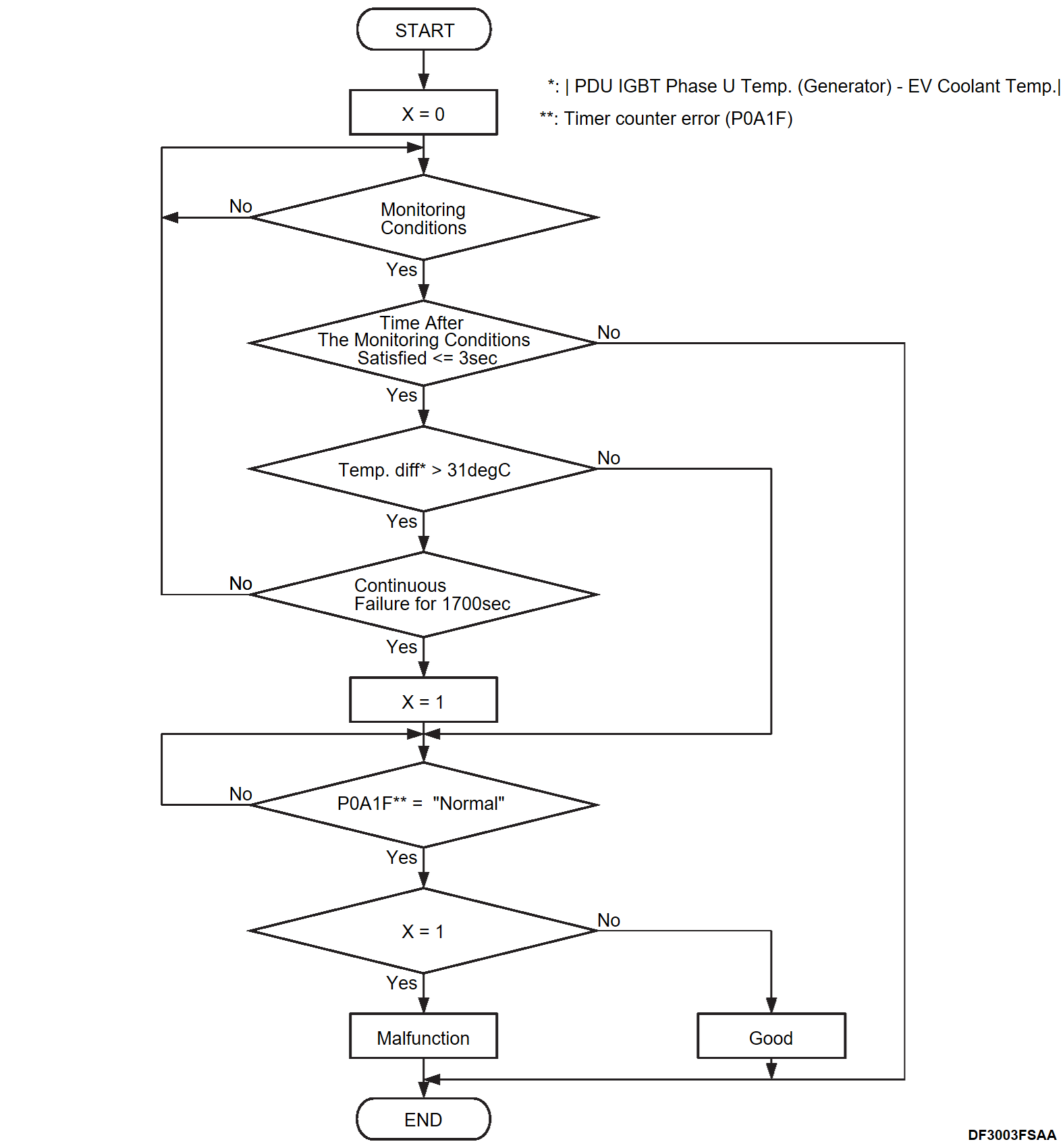DTC No. P0A01-00 Motor Elec. Coolant Temp. Sensor "A" Circuit Range/Performance
MONITOR EXECUTION
- Once per driving cycle
MONITOR EXECUTION CONDITIONS (Other monitor and Sensor)
Other Monitor (There is no temporary DTC set in memory for the item monitored below)
- BMU2 monitor
Sensor (The sensor below is determined to be normal)
- Not applicable
DTC SET CONDITIONS
Check Condition
- The PHEV-ECU power supply voltage is 9.0 V or more.
- The IGBT status of GCU is off (shutdown).
- Time after above conditions satisfy is less than 3 seconds.
- The soaking time is more than 2,700 seconds.
- The EV power source relay drive signal is on.
Judgment Criterion
- The absolute value of the difference between the value of EV coolant temperature and the value of power drive unit IGBT temperature is more than 31°C (88°F) for 1,700 seconds.
OBD-II DRIVE CYCLE PATTERN
- Refer to OBD-II Drive Cycle OBD-II DRIVE CYCLE
 .
.
TROUBLESHOOTING HINTS
- Malfunction of the EV coolant temperature sensor.
- Malfunction of the EV coolant temperature sensor circuit.
- Malfunction of the PHEV-ECU.
DIAGNOSIS
Required Special Tools:
- MB992744: Vehicle communication interface-Lite (V.C.I.-Lite)
- MB992745: V.C.I.-Lite main harness A
- MB992747: V.C.I.-Lite USB cable short
- MB992748: V.C.I.-Lite USB cable long
- MB991223: Wiring harness set
- MB992006: Extra fine probe
1.M.U.T.-IIISE other system DTC
Check whether the power drive unit sets the DTC (Refer to DIAGNOSTIC TROUBLE CODE CHART ).
).
 ).
).Is the DTC set?
2.M.U.T.-IIISE data list
Check the following PHEV-ECU data list.
- Item No. 660: Water temperature sensor voltage (EV)
OK:
- Approximately 4 V [at 0°C (32°F)]
- Approximately 3.5 V [at 20°C (68°F)]
- Approximately 2.7 V [at 40°C (104°F)]
- Approximately 1.9 V [at 60°C (140°F)]
Is the check result normal?
3.Check the signal line for damage, open, short to ground and short to power supply circuit (EV coolant temperature sensor connector and the PHEV-ECU connector).
Check the wiring harness between EV coolant temperature sensor connector and the PHEV-ECU connector (WTS terminal).
Is the check result normal?
4.Check the ground line for damage, open, short to ground and short to power supply circuit (EV coolant temperature sensor connector and the PHEV-ECU connector).
Check the wiring harness between EV coolant temperature sensor connector and the PHEV-ECU connector (WTSG terminal).
Is the check result normal?
5.EV coolant temperature sensor check
Check the EV coolant temperature sensor [Refer to Electric Motor Control Unit (EMCU) and Motor (Electric Motor Unit) - EV Coolant Temperature Sensor Inspection EV COOLANT TEMPERATURE SENSOR INSPECTION ].
]. Replace the EV coolant temperature sensor [Refer to Electric Motor Control Unit (EMCU) and Motor (Electric Motor Unit) - Power Drive Unit POWER DRIVE UNIT REMOVAL AND INSTALLATION
Replace the EV coolant temperature sensor [Refer to Electric Motor Control Unit (EMCU) and Motor (Electric Motor Unit) - Power Drive Unit POWER DRIVE UNIT REMOVAL AND INSTALLATION ]. Then,
]. Then, 
 ].
].Is the check result normal?
 Replace the EV coolant temperature sensor [Refer to Electric Motor Control Unit (EMCU) and Motor (Electric Motor Unit) - Power Drive Unit POWER DRIVE UNIT REMOVAL AND INSTALLATION
Replace the EV coolant temperature sensor [Refer to Electric Motor Control Unit (EMCU) and Motor (Electric Motor Unit) - Power Drive Unit POWER DRIVE UNIT REMOVAL AND INSTALLATION ]. Then,
]. Then, 
6.Test the OBD-II drive cycle.
(1) Carry out a test drive with the drive cycle pattern. Refer to OBD-II Drive Cycle OBD-II DRIVE CYCLE .
.
 .
.(2) Check the DTC.
Is the DTC set?
 Replace the PHEV-ECU (Refer to PHEV-ECU REMOVAL AND INSTALLATION
Replace the PHEV-ECU (Refer to PHEV-ECU REMOVAL AND INSTALLATION ). Then,
). Then, 
 The trouble can be an intermittent malfunction (Refer to General Information - How to Use Troubleshooting/Inspection Service Points, How to Cope with Intermittent Malfunctions HOW TO COPE WITH INTERMITTENT MALFUNCTIONS
The trouble can be an intermittent malfunction (Refer to General Information - How to Use Troubleshooting/Inspection Service Points, How to Cope with Intermittent Malfunctions HOW TO COPE WITH INTERMITTENT MALFUNCTIONS ).
).7.Test the OBD-II drive cycle.
(1) Carry out a test drive with the drive cycle pattern. Refer to OBD-II Drive Cycle OBD-II DRIVE CYCLE .
.
 .
.(2) Check the DTC.
Is the DTC set?
 Retry the troubleshooting.
Retry the troubleshooting. The procedure is complete.
The procedure is complete.![[Previous]](../../../buttons/fprev.png)
![[Next]](../../../buttons/fnext.png)
